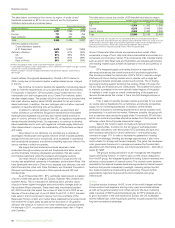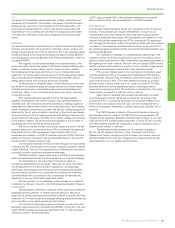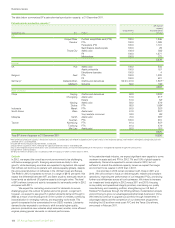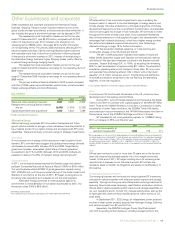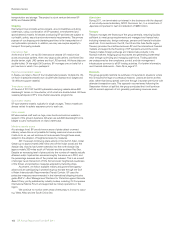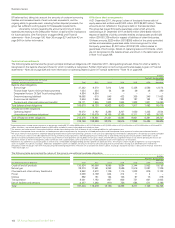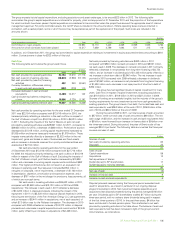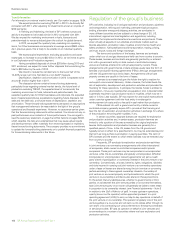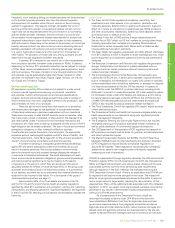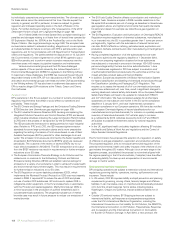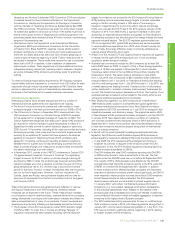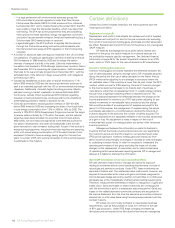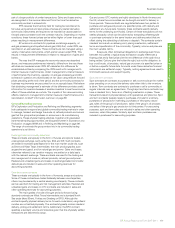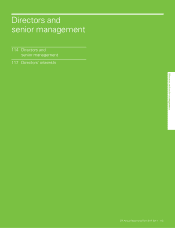BP 2011 Annual Report Download - page 110
Download and view the complete annual report
Please find page 110 of the 2011 BP annual report below. You can navigate through the pages in the report by either clicking on the pages listed below, or by using the keyword search tool below to find specific information within the annual report.
108 BP Annual Report and Form 20-F 2011
Business review
by individuals, corporations and governmental entities. The ultimate costs
for these claims cannot be determined at this time. We also expect the
industry in general, and BP in particular, to become subject to greater
regulation and increased operating costs in the Gulf of Mexico in the
future. For further disclosures relating to the consequences of the 2010
Deepwater Horizon oil spill, see Legal proceedings on page 160.
On 31 March 2009, the United States filed a complaint seeking civil
penalties and damages relating to oil leaks from oil transit lines operated by
BP Exploration (Alaska) Inc. (BPXA) at the Prudhoe Bay unit on the North
Slope of Alaska. (See Legal proceedings on page 165.) The complaint also
involved claims related to asbestos handling, allegations of non-compliance
at multiple facilities for failure to comply with EPA’s spill prevention plan
regulations, and for non-compliance with US Department of Transportation
orders and regulations. The parties settled the dispute and on 13 July 2011
the Court entered a Consent Agreement in which BPXA agreed to pay a
$25-million penalty and to perform certain injunctive measures over the
next three years with respect to pipeline inspection and maintenance.
Various environmental groups and the EPA have challenged
certain aspects of the air permits issued by the Indiana Department of
Environmental Management (IDEM) for upgrades to the Whiting refinery.
In response to these challenges, the IDEM has reviewed the permits and
responded formally to the EPA. BP is in discussions with EPA, the IDEM
and certain environmental groups over these and other CAA issues relating
to the Whiting refinery. BP has also been in settlement discussions with
EPA to resolve alleged CAA violations at the Toledo, Carson and Cherry
Point refineries.
European Union
BP’s operations in the EU are subject to a number of current and proposed
regulatory requirements that affect or could affect our operations and
profitability. These include:
• The EU Climate and Energy Package and the Emissions Trading Scheme
(ETS) Directive (see Greenhouse gas regulation on page 109).
• The EU Industrial Emissions Directive (IED) (revising and replacing the
Integrated Pollution Prevention and Control Directive (IPPC) and several
other industrial directives including the Large Combustion Plant Directive
(LCPD)) are in the process of transposition by the EU Member States.
The IED provides the framework for setting permits for major industrial
sites. Relative to IPPC and LCPD, the IED imposes tighter emission
standards for some large combustion plants and is more prescriptive
regarding the setting of emission of limit values based on use of Best
Available Techniques (BAT) in permits for other discharges to air and
water. The emission limit values are informed by the Sector specific and
cross-Sector BAT Reference documents (BREFs) which are reviewed
periodically. The outcome of the review of several BREFs key to our
major sites is expected in 2012/2013. The IED transposition and output
from the BREF revisions may result in requirements for further emission
reductions at our EU sites.
• The European Commission Thematic Strategy on Air Pollution and the
related work on revisions to the Gothenburg Protocol and National
Emissions Ceiling Directive (NECD) will establish national ceilings for
emissions of a variety of air pollutants in order to achieve EU-wide health
and environmental improvement targets. This may result in requirements
for further emission reductions at our EU sites.
• The EU Regulation on ozone depleting substances (ODS), which
implements the Montreal Protocol (Protocol) on ODS was most recently
revised in 2009. It requires BP to reduce the use of ODS and phase
out use of certain ODS substances. BP continues to replace ODS in
refrigerants and/or equipment, in the EU and elsewhere, in accordance
with the Protocol and related legislation. Methyl bromide (an ODS) is
a minor by-product in the production of purified terephthalic acid in
our petrochemicals operations. The progressive phase-out of methyl
bromide uses may result in future pressure to reduce our emissions of
methyl bromide.
• The EU Fuels Quality Directive affects our production and marketing of
transport fuels. Revisions adopted in 2009 mandate reductions in the
life cycle GHG emissions per unit of energy as described in Greenhouse
gas regulation above, and tighter environmental fuel quality standards
for petrol and diesel (for example see Greenhouse gas regulation on
page 109).
• The EU Registration, Evaluation and Authorization of Chemicals (REACH)
Regulation requires registration of chemical substances, manufactured
in, or imported into, the EU in quantities greater than 1 tonne per annum
per legal entity, together with the submission of relevant hazard and
risk data. REACH affects our refining, petrochemicals, exploration and
production, biofuels, lubricants and other manufacturing or trading/import
operations.
• Having completed registration of all the substances that we were
required to submit by the regulatory deadline of 1 December 2010,
we are now preparing registration dossiers for those substances
(manufactured or imported in amounts in the range 100-1,000 tonnes
per annum/legal entity) that are due to be submitted before 1 June
2013. Substances registered in 2010 are subject to evaluation and/
or authorization/restriction procedures by the authorities and this may
impact activities, product sales and their profitability.
• In addition, Europe has adopted the UN Global Harmonization System
for hazard classification and labelling of chemicals and products through
the Classification Labelling and Packaging (CLP) Regulation. This
requires us to assess the hazards of all of our chemicals and products
against new criteria and will, over time, result in significant changes to
warning labels and material safety data sheets. All our European Material
Safety Data Sheets will need to be updated to include both REACH
and CLP information. We have completed updates for all chemicals
substances we manufacture and market in the EU by the compliance
deadline of 3 January 2011, and have implemented a process to
maintain compliance in our European operations. We have also notified
the European Chemicals Agency of hazard classifications for our
manufactured and imported chemicals, for inclusion in a publicly available
inventory of hazardous chemicals. CLP will also apply to mixtures
(e.g. lubricants) by 2015. Activities covered by both CLP and REACH
are subject to possible enforcement activity by national regulatory
authorities.
• In the UK, significant health and safety legislation affecting BP includes
the Health and Safety at Work Act and regulations and the Control of
Major Accident Hazards Regulations.
The EU Commission has proposed the adoption of a regulation on safety
of offshore oil and gas prospection, exploration and production activities.
The proposed regulation aims to introduce harmonized regulation of the
potential environmental, health and safety impacts of the offshore oil and
gas industry throughout EU waters. Although it is at an early stage in the
legislative process, as published the proposal is not entirely aligned with
the regime operating in the UK and could also, if adopted, have the effect
of extending liability for clean-up and compensation of environmental
damage to marine waters.
Environmental maritime regulations
BP’s shipping operations are subject to extensive national and international
regulations governing liability, operations, training, spill prevention and
insurance. These include:
• In US waters, OPA 90 imposes liability and spill prevention and planning
requirements governing, among others, tankers, barges and offshore
facilities. It also mandates a levy on imported and domestically produced
oil to fund the oil spill response. Some states, including Alaska,
Washington, Oregon and California, impose additional liability for oil
spills.
• Outside US territorial waters, BP Shipping tankers are subject to
international liability, spill response and preparedness regulations
under the UN’s International Maritime Organization, including the
International Convention on Civil Liability for Oil Pollution, the MARPOL,
the International Convention on Oil Pollution, Preparedness, Response
and Co-operation and the International Convention on Civil Liability
for Bunker Oil Pollution Damage. In April 2010, a new protocol, the


